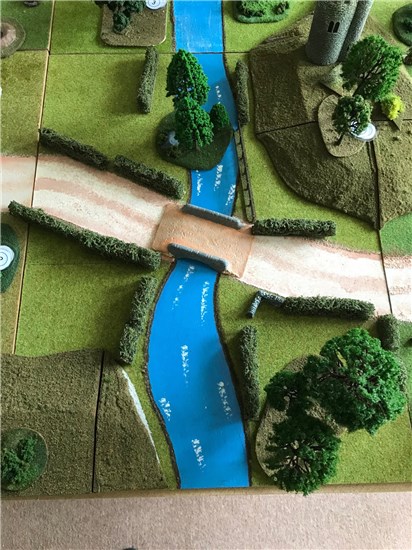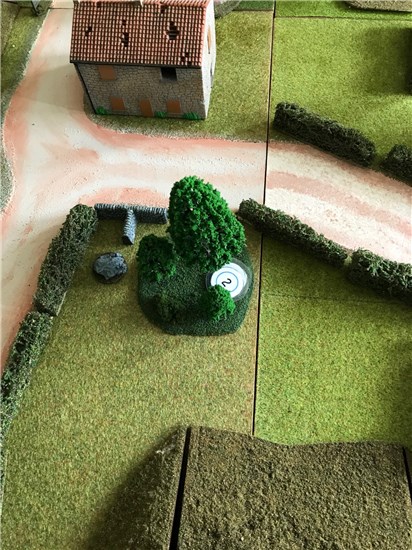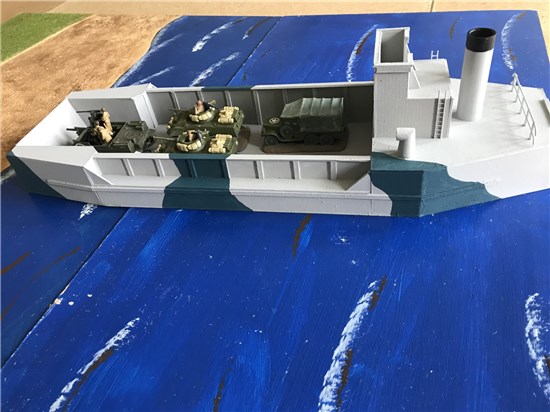I have recently joined a local tabletop gaming club - a bunch of guys (probably half my age) who play a lot of Warhammer, Star Wars, X-Wing, Magic The Gathering and other modern sci-fi or post-apocolyptic type games with some wonderful figures, machinery and terrain. They used to have a "Historical Gaming" section but that dried up during the lockdown. I am on a one-man crusade to bring it back and have played a couple fo FYOB games since joining.
I envy those people who can bash a scenario together in a few days and it turns out to be perfect. Therefore, for my first game at the Club, I went to an old faithful - a Lost Pilot game. Table space is at a premium so I ended up with half a table-tennis table giving me 4ft 6in x 4ft. Smaller than I am used to, but given I only have 4 hours to set up, play and break down, it actually works out well.


Above - two views of the board I used. I went for the full array of baseboards, hedges, hills and trees to show off my scenery and make sure it looked good. On the night, a guy joined me and played the Germans under my guidance, using the solo rules. It worked out fine although he was a bit more cautious given he didn't know the rules. The right hand picture shows one of the markers used as possible hiding places - I put 3 on the board and gave each side 3 playing cards. They were shuffled, placed face down and turned over when the CO was activated. The result told him where his "intelligence" network thought the airmen would be.
The Germans discovered the 2 fliers first only to lose them during a fire-fight with a feisty British platoon. The British NCO, however, failed a Leadership Test when trying to persuade the fliers to go with him - perhaps they were French??? In an effort to get the pilots back, the Germans attacked the British platoon and, with the last throw of the dice, wiped out both the platoon and the airmen!!! I guess we call that a draw..........
Back to Sicily
Last night I played a re-run of the Gela Harbour game last seen in some poor pictures taken in the loft of my old house. Again, a smaller set-up on 4ft 6in x 4ft. For this one, newly painted Americans took on German defenders and called on a new secret weapon.

Based on a photograph in the Rapid Fire! Normandy Scenarios book, this is made from 1mm framers card with a bit of tube for the funnel and some railings/ladders found in the scrap box. The ventilation bells are from the German trawler which (I regret) I am yet to get around to. I am on the hunt for some Oerlikon cannons, or similar, for the rear deck and have printed (but not yet added) the transfers for the bow. The armour on board represents the American reserves for the game.
On the night, 10 bounds of action saw the Americans sweep all before them early on before losing the ability to make any decent dice rolls. The German ATG took out the Priest whilst the Raketenwerfer on its first outing accounted for an M8 Greyhound. American Bazooka teams were called up to deal with the German reserves, a pair of Panzer IVD's with their 75mm L24 guns, but couldn't hit, nor turn hits into damage. I called the game with the Germans desperately short of infantry to protect their tanks, a US unit preparing a flank attack on the German HQ and the second M8 about to take on the Big Cats.
Other Developments
The need for new games has also spurred me on to make some new scenic stuff and finish other projects. These include, in no particular order;
- some hill modules that include roads - a couple of "slopes", a straight road and a "T" junction. They were used in the Gela game and worked well so I will get around to making some more straight roads and maybe a bend.
- The US Infantry Battalion is now complete although my hours of painting was not rewarded by their performance the other night. When the chips were down, they proved unable to shoot straight!!
- A forthcoming "Raid on Jersey" game will use the German guard dogs I bought about 10 years ago. Painting has started so I look forward to using them for the first time. Heroes All includes rules for guard dogs under "Observation".
- I have recently acquired and built a few new vehicles including a Kfz 13 car for German scouts (with a LMG), a German Recovery truck to match the Scammel the British have, a 150mm Nebelwerfer (3D print) with crew and some Fallschirmjager support weapons like MMGs, mortars and a sniper team
- I have added a couple of new baseboards as I didn't seem to have certain combinations of road/river sections to suit some configurations.
- I managed to pick up some cheap "Spruce" type trees on eBay, about 6 or 7 inches high so a decent size. These have been mounted on bases as usual and complete my woodland collection. Some can be seen on the photos above.
- Some of the older buildings I had have been disposed of. The older AIrfix cottages etc are really passed it and although they are being held in reserve, they have made space in the storage boxes for anything new I come across.
- My next acquisition will be some ploughed fields and wheat fields. I have some material for these, including an old Koi doormat. I need to experiment with paint and stuff.
So thats me up to date! I will add some more in due course but don't expect a weekly blog - that's not my thing. I am still working on FYOW and have started the final Test campaign so, fingers crossed, that goes well and I can finally publish the outcome. In the interim, happy gaming.